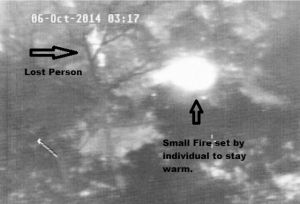Helicopter helps save boater
By John Joyce
Published in News on October 7, 2014 1:46 PM

Airwatch deputies flying the Wayne County Sheriff's Office helicopter, the Nighthawk, used their Forward Looking Infrared Radar (FLIR) to locate a fire set by a boater lost in a swamp in Duplin County early Monday morning. It was the first time FLIR had been used in a live search and rescue operation. The Airwatch unit located the boater in less than one minute on station.
It took less than one minute for the Wayne County Sheriff's Office helicopter, the Nighthawk, to locate a missing boater in Duplin County early Monday morning.
The search for the man had been going on for hours.
"It was actually about 20 seconds," Maj. Tom Effler said.
The boater, whose name is not being released, put into a Cape Fear River tributary near a bridge on John David Grady Road at 11:30 Sunday morning.
His wife was to meet him at 10 p.m. at another bridge down river.
He never showed.
"The call came in at 12:30 Monday morning," Arrington Fire Department Chief Randy Rogers said.
By the time his agency was called, Duplin County first responders had already set up a command post.
"The family got concerned and called the Pleasant Grove Fire Department. They went to look for him and decided they needed assistance," Rogers said.
Rogers said the boater realized he was not going to make his destination and tried to turn back, but lost his way.
The Duplin County Sheriff's Office, Pleasant Grove, Albertson and Pink Hill fire departments responded along with Duplin County EMS and Duplin Search and Rescue.
They then called in Arrington Fire Department's Arr-Mac Water Rescue team for assistance.
"We were able to work together and come up with a plan everybody agreed with," Rogers said.
The final piece of that plan included calling in the Nighthawk.
Maj. Daryll Overton got the call and approved the use of the helicopter, and Lt. Tom Parker and Deputy Joey Sutton took to the air.
The Nighthawk arrived on site at 3:16 a.m.
At 3:17, the boater was found on land in a heavily wooded area, next to a small fire.
Without the help of the air unit, the search could have taken countless hours, Rogers said.
"If we would have had to do it by boat, we would have had to search every one of those little tributaries. We had no idea exactly where he could be," he said.
The difficulty of the search was compounded by two factors.
One, the missing man is a diabetic.
And two, it was getting colder by the hour.
"It still took us an hour to get our ground crews to work their way to him," Rogers said.
"There is a dense canopy over the area. It's more or less a swamp," he said.
The Nighthawk located the fire first, then the man, using its Forward Looking Infrared Radar, or FLIR.
It was the first time the FLIR had been used in a live search and rescue.
Rogers said the victim aided in his own rescue by starting the fire, but more importantly, he did what most lost people fail to do correctly, he stayed put.
"We finally made contact with him, and he was OK," Rogers said.
Anyone planning a hike or boating excursion should keep in mind a few safety tips in case the worst should happen.
"Take all personal protective equipment, including a personal flotation device. Pack provisions, some food and water and extra clothing. And bring a cell phone in a waterproof pouch," Rogers said.
And be certain to tell someone where you are going and what time you expect to be back, so if you don't make it by then, someone knows you are missing, he said.
